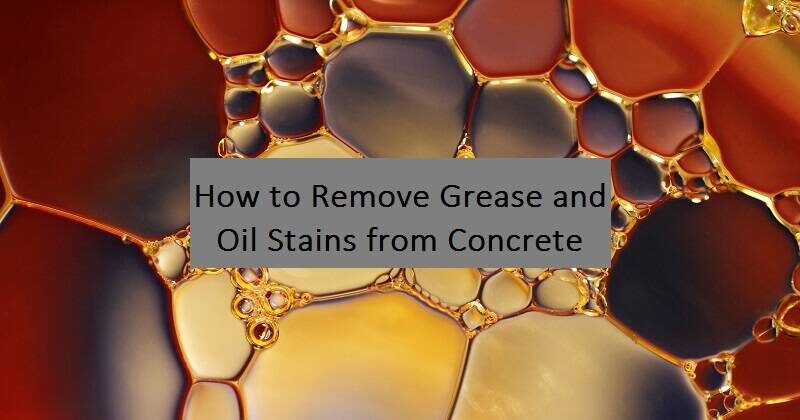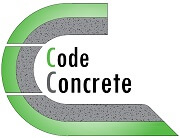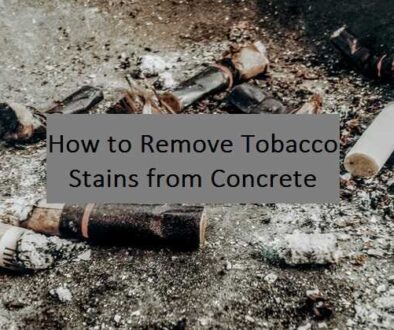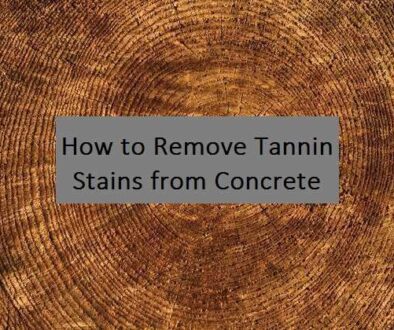How to Remove Grease and Oil Stains from Concrete

Last updated on February 9th, 2023
Many home owners wonder how to remove grease and oil stains from concrete surfaces, including driveways, countertops, garages, and walls. Sometimes, people try different removal methods, which turn out to be unsatisfactory, and simply give up thinking that those stains are impossible to remove. Even worse, some try inadequate methods, either mechanical or chemical, which might be successful in removing the stain, but cause significant damage to the concrete.
In this article, we will present the ideal methods for the removal of grease and oil stains from concrete surfaces using different techniques, household products, other chemicals, and special commercial products.
Factors that affect the toughness of the stain
There are mainly three factors that can significantly influence the toughness of grease and oil stains on concrete:
- Type of grease or oil: Some oils are less viscous than others and can easily penetrate the surface of concrete, and at a higher rate. In addition, the chemical composition of grease and oils also plays a major role in the toughness of the stain.
- Age of the stain: In general, fresh grease or oil spills are easier to clean and remove than older ones. This is mainly due to the fact that old stains are deeper, and some oils can dry out inside the pores of concrete, making them harder to remove.
- And surface porosity of concrete: In brief, as the porosity of concrete increases, the penetration rate of oils increase as well. However, the higher porosity can sometimes make it easier to remove the stain, and thus increasing the effectiveness of the removal method.
Prevention and protection is always your best solution
Although you can apply different methods to remove almost any grease and oil stains from concrete, it is always better to prevent these stains at the first place. Mainly, such stains are common in driveways, garage floors, and concrete countertops.

In driveways and garage floors, one of the most common causes for oil stains is a vehicle with oil leakage. Thereby, a preventive method simply includes fixing this leakage and performing proper routine car maintenance. Whereas, a protection method includes sealing the driveway or garage floor with an adequate type of sealers.

On countertops, different types of grease and oil can cause stains. These can include drying, semi-drying, and non-drying oils, in addition to cooking grease or grill grease, with different temperatures. In fact, such stains are mainly caused either by spillage or splattering and splashing. Thereby, preventive and protection methods may include proper design and covering the area subject to oil stains during certain works, and applying an adequate sealer for concrete countertops.
How to remove grease and oil stains from concrete: The ideal methods
In this article, we will address different types of removal methods including poultices, bandages, and special commercial products. However, most of these methods share a pre-requisite step which is essential for their success, especially for new spills.
The initial step for the removal of new grease and oil stains from concrete

This is a crucial initial step for the absorption of any new grease and oil spills. Besides, it is a pre-requisite for most of the subsequent stain removal methods. Mainly, its aim is to limit the spread of the stain, and to soak up or absorb as much of the new spill as possible. In fact, this step can sometimes be sufficient for the complete removal of the spill, without leaving any stains, especially when immediate action is taken.
Things you will need
- Sand / sawdust / cat litter.
- Absorptive cloth / paper towels.
- Broom and shovel.
- Bristle brush.
- Gloves.
- Tri-sodium phosphate / laundry detergent / strong soap.
- Warm water.
Notes
- Trisodium Phosphate: Other names include Sodium Orthophosphate, TSP, or Phosphate of Soda.
Appearance: White crystalline odorless powder.
Availability: It is available at the supermarkets.
Hazards: It is corrosive to flesh. - Similarly, laundry detergents and strong soap can be corrosive to flesh, and cause irritations.
Procedure
- If the amount of spillage is large, use sand or other powders to surround the liquid and prevent its further spread.
- Use an absorptive cloth or paper towels to gently soak up as much surface grease or oil as possible, without any rubbing.
- Remove the surrounding sand.
- Apply sand, sawdust, or cat litter to the stain and leave it for about 24 hours.
- Remove the sand and any residue using a broom and shovel. You can use a bristle brush to help scrape off any solidified grease or oil that are tough for the broom.
- Put on your gloves, and scrub the surface with warm water and TSP, laundry detergent, or strong soap using a bristle brush.
- And finally, rinse and flush the surface with clean water.
Explanation
In this procedure, you should start first by limiting the spread of the stain, especially if the spillage is large, or if the surface is inclined. Accordingly, you can use sand or other absorptive powders to surround the spill and limit its spread. Besides, timing is crucial here, and taking an immediate action can significantly reduce confine the issue.
Then, use paper towels or an absorptive cloth to soak up the grease or oil. During the soak up step, it is important not to wipe or rub the surface, as this can further spread the stain, especially if you did not perform the first step. Instead, you should gently place the paper towel or cloth on the spill, and let it soak up the surface oil. Next, remove the surrounding sand, and place a layer of sand, sawdust, cat litter, or other absorptive powder right on the spot. In this step, it is preferable to for the absorptive powder layer to cover an area slightly larger than that of the stain.
After 24 hours, use a broom and a shovel to remove this layer completely. Here you can also use a bristle brush to scrape off the solidified material. Then, put on your gloves, and mix tri-sodium phosphate (TSP) with warm water according the product’s dosage. Or, prepare a mixture of laundry detergent or strong soap with warm water. Next, scrub the spot with this mixture using a bristle brush, without excessive pressure, and in circular motion. Finally, rinse the surface thoroughly with clean water.
Sometimes, this process can be more than sufficient to completely remove the grease or oil spill and stain, depending on several factors as we previously mentioned. However, if the stain persists, you can apply one of the subsequent methods.
Method #1: How to remove grease and oil stains from concrete using a poultice

This method is generally highly effective for small tough stains, and involves mostly the use solvent poultices to break down and absorb the stain.
Things you will need
- Sawdust / talc powder / cat litter.
- Safety gear.
- (Lime and mineral spirits) / (TSP, sodium perborate, and soap) / TSP / kerosene / carbon tetrachloride / benzene.
- Plastic sheet.
- Warm water.
- Bristle brush.
- Soap / laundry detergent.
- Water.
Notes
- Mineral Spirits: Other names include Mineral Turpentine, Refined Naphtha, and White Spirit.
Appearance: Clear liquid.
Availability: It is available at paint supply stores.
Hazards: Irritant and flammable. - Trisodium Phosphate: Other names include Sodium Orthophosphate, TSP, or Phosphate of Soda.
Appearance: White crystalline odorless powder.
Availability: It is available at the supermarkets.
Hazards: It is corrosive to flesh. - Sodium Perborate: Other names include Perboric acid, Perborax, or Sodium salt.
Appearance: White crystalline odorless powder.
Availability: It is available at the supermarkets and chemical supply centers. It is used in some dishwashing powders and laundry detergents.
Hazards: Strong oxidizer, irritant. - Kerosene: Also known as Paraffin Oil or Lamp Oil.
Appearance: Colorless or slightly yellowish liquid.
Availability: It is available at hardware stores and gas stations.
Hazards: Toxic, flammable. - Carbon Tetrachloride: Other names include Perchloromethane and tetrachloromethane.
Appearance: Clear colorless liquid.
Availability: It is available at pharmacies, cleaning supply centers, and paint stores.
Hazards: Toxic, carcinogenic. - Benzene: Other names include Benzol or Coal Naphtha.
Appearance: Colorless liquid.
Availability: It is available at chemical, hardware, and paint stores.
Hazards: Highly flammable, toxic, carcinogenic. - Laundry detergents and strong soap can be corrosive to flesh, and cause irritations.
Procedure
- Put on your safety gear.
- Prepare a poultice: Mix talc, sawdust, or cat litter with one of the following to form a thick paste:
- Mineral spirits.
- 1 part TSP, 1 part sodium perborate, and (liquid soap) or (soap and hot water).
- 1 part TSP and 6 parts water.
- Kerosene, carbon tetrachloride, or benzene.
- Apply the poultice to the stain with a thickness of about 1/4 inches (~6mm), covering an area of about 3 inches (~76mm) wider than the stain.
- Cover the poultice with a plastic sheet.
- Let it stand for a certain period of time till dry, generally as follows based on the poultice type:
- Lime and mineral spirits: 24 hours.
- TSP, sodium perborate, and soap: 24 hours.
- TSP and water: 24hours.
- Kerosene, carbon tetrachloride, or benzene: few hours.
- Remove the plastic sheet cover.
- Scrape off the residue using a bristle brush.
- Rinse with clean water.
- Scrub with warm water and laundry detergent or soap using a bristle brush.
- Rinse and flush thoroughly with clean water.
Explanation
After performing the initial step that we previously explained (if the spill is new), you should start first by wearing a protective gear; your safety is a priority. Then, prepare a poultice by mixing sawdust, cat litter, or talc powder with certain chemical(s) to form a thick paste.
But in this method, we addressed four different poultices. In fact, each can vary in effectiveness depending mainly on their composition and on the type of oil. For this reason, we will briefly explain the effectiveness, benefits, and best applications for these poultices.
a. Lime and mineral spirits
This poultice can be effective on different types of oil stains, but is best for those of drying oils including linseed, tung, walnut, soybean, and other oils. In brief, you can mix 1 part lime and 2 parts mineral spirits to form a thick paste.
b. TSP, sodium perborate, and soap
This poultice is also most effective for removing drying oil stains from concrete. However, comparing it to the lime and mineral spirits poultice, this is more effective and can remove tougher and older stains. Basically, you can mix 1 part TSP, 1 part sodium perborate, and liquid soap or soap and hot water with about 3 parts talc powder to form the paste.
c. TSP and water
This is a simple poultice which can be suitable for removing grease or lubricating and petroleum oil stains from concrete. It consists of mixing an aqueous TSP solution (1:6 TSP to water) with talc powder.
d. Kerosene, carbon tetrachloride, or benzene
This is a highly effective poultice for the removal of grease or lubricating and petroleum oil stains from concrete surfaces. However, care should be taken due to the hazards of the chemical compounds. This poultice consists of mixing talc powder with kerosene, carbon tetrachloride, or benzene to form a thick paste.
Then, apply the thick paste to the stain, with a thickness of about 1/4 inches (~6mm). Also, it is important for this layer to cover a margin of about 3 inches (~76mm) out of the stain edges. Next, cover the fresh paste with a plastic sheet to increase the effectiveness of the poultice, and let it stand for a certain period of time, as we previously explained. Afterwards, remove the plastic sheet cover, and use a bristle brush to scrape off the residue and solidified materials, and rinse with clean water. Then, mix laundry detergent or soap with warm water, and scrub the surface with this solution using a bristle brush. And finally, rinse and flush with clean water.
Method #2: How to remove grease and oil stains from concrete using a bandage

This method can also be highly effective for small, lubricating or petroleum grease and oil stains. It mainly involves the application of a bandage saturated with a solution of acetone and amyl acetate.
Things you will need
- Safety gear.
- Cotton ball or pad / absorptive cloth.
- Acetone.
- Amyl acetate.
- Hot flat piece of stone.
- Laundry detergent.
- Warm water.
- Bristle brush.
- Water.
Notes
- Acetone: Other names include Propanone and Dimethyl Ketone.
Appearance: Colorless liquid.
Availability: It is available at the supermarkets, and pharmaceutical and beauty supply stores.
Hazards: Highly flammable and volatile. - Amyl Acetate also known as Banana Oil.
Appearance: Colorless liquid.
Availability: It is a solvent available at chemical supply centers and cloth cleaning stores.
Hazards: Toxic. - Similarly, laundry detergents and strong soap can be corrosive to flesh, and cause irritations.
Procedure
- Wear your protection gear.
- Mix 1 part acetone with 1 part amyl acetate.
- Saturate a cotton ball, pad, or a piece of cloth with the solution.
- Apply the bandage to the stain.
- Place a relatively hot piece of stone on top of the bandage.
- Remove the stone and the bandage after about an hour, or when the bandage dries.
- Re-saturate the bandage with the solution and repeat if needed.
- Scrub the surface with warm water and laundry detergent using a bristle brush
- Rinse and flush thoroughly.
Explanation
Following the initial step which we previously explained, put on your safety gear. Then, mix 1 part of acetone with 1 part of amyl acetate to prepare the bandage mixture, in a well ventilated area. Next, dip a cotton, pad, or a clean piece of absorptive cloth in the mixture to saturate it, and apply right on the stain. However, it is important to note that the bandage should cover a margin of about 3” (~76mm) larger than the stain.
Then, while the bandage is still saturated, place a relatively hot flat piece of stone on the bandage. This process will promote the absorption of the oil towards the stone. However, be careful with the temperature since acetone is highly flammable. Next, after the bandage dries, generally in about an hour or so, remove the stone and the bandage and check its effectiveness. If the stain remains but is reduced, you can re-saturate the bandage and replace the stone on top until it removes the stain completely. Finally, scrub the surface with warm water and laundry detergent using a bristle brush, and then flush with clean water.
Method #3: How to remove grease and oil stains from concrete using commercial emulsifying agents, cleaners, degreasers, or special products

This method involves the use of commercial products which are specifically designed to remove oil stains from concrete.
Things you will need
- Follow the manufacturer’s instructions.
Explanation
In general, you should apply commercial oil stain removal products after performing the initial preparatory step, or at least part of it, which we explained first. Besides, these products are widely available in the market, with different and sometimes proprietary compositions. Such products range from basic concrete cleaners and degreasers, to more advanced ones which work upon a microbial cleaning action, and can contain bacterial spores that “eat” oil.
Basically, concrete cleaners and degreasers are relatively cheap and easy to use. However, their effectiveness depends on the type of oil, age of stain, and the porosity of concrete. Thereby, most of these products are not highly effective on stubborn and old oil stains, especially when the concrete porosity is low.
Whereas, more advanced products which have a microbial cleaning action are generally more expensive and take significantly more time to remove grease and oil stains. But such products can be highly effective even on the toughest stains, due to their working mechanism. In addition, they can be water based, biodegradable, non-toxic, and friendly to the environment, which gives them a huge advantage over basic cleaners.
Frequently asked questions
Will steam cleaning help in removing oil stains from a concrete floor?
Steam cleaning can be highly effective for cleaning such stains, especially with the combined effect of some chemicals such as sodium hydroxide. However, some chemicals can cause bleaching, and discoloration, thereby care should be taken and testing can be done on a small area first.
Conclusion
Oil spills on concrete floors, and countertops, is a quite common issue. Many homeowners wonder how to completely remove such stains, or if it is even possible, without damaging the surface. However, there are different types of oils, which may require different removal methods. In addition, the effectiveness of the methods can be highly dependent on the type of oil, age of the stain, and the porosity of concrete. Accordingly, this article presented the ideal removal methods, including the pre-requisite step, poultice methods, bandage method, and commercial products, with different effectiveness and for different types of oils.
However, although most grease and oil stains can be removed, it is more important to consider preventive or protective methods. These can include covering exposed concrete during certain work, fixing oil leaks (e.g. vehicles), or applying a sealer to provide the best protection.




